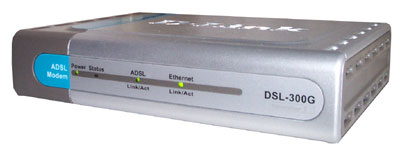Blocked Ports on DLink DSL-300G GenII ADSL Modem
This page provides information on a workaround for blocked inbound
TCP ports on a DLink DSL-300G Generation II ADSL modem.

DLink DSL-300G Generation II ADSL modem
Blocked Ports Inbound
When operating in PPPoE or PPPoA mode, the DSL-300G blocks inbound connection attempts
on TCP port 23 (telnet) and port 80 (http).
Apparently this is due to modem's webserver and telnet server, even though they are
not listening on the modem's adsl interface.
This problem is known to exist on DSL-300G Generation II ADSL modems with firmware version
R2.01M.B6.AU(021206a/T93.3.44)
I haven't had any feedback from anyone who has a different firmware version in their DSL-300G modem.
This will cause issues if you want to publicly expose a telnet or webserver behind your
DSL-300G modem.
In September 2004, a DLink Australia representative informed me that a future firmware
release will address this issue.
However, an ETA could not be provided, but the representative expects it to be available soon.
However, it's a relatively easy exercise to change the ports used by the modem's
telnet and webserver.
To do so, connect to the modem's telnet server:
telnet 10.1.1.1
Login using admin as the username and password.
To change the modem's webserver port, use the following command (and use a different port,
if required):
modify nbsize httpport 8000
and to change the modem's telnet port, use the following:
modify nbsize telnetport 9000
Save your changes to the modem's flash memory, and reboot the modem to make
your changes take effect:
commit
reboot
Note that you can no longer access the modem's web interface using port 80.
Instead of using
http://10.1.1.1
you'll now need to
http://10.1.1.1:8000
and similarly for the modem's telnet server.
Credits
Thanks to
Samuel
for making me aware of the problem, and for contacting DLink about a workaround.
last updated 8 Feb 2015
| 
